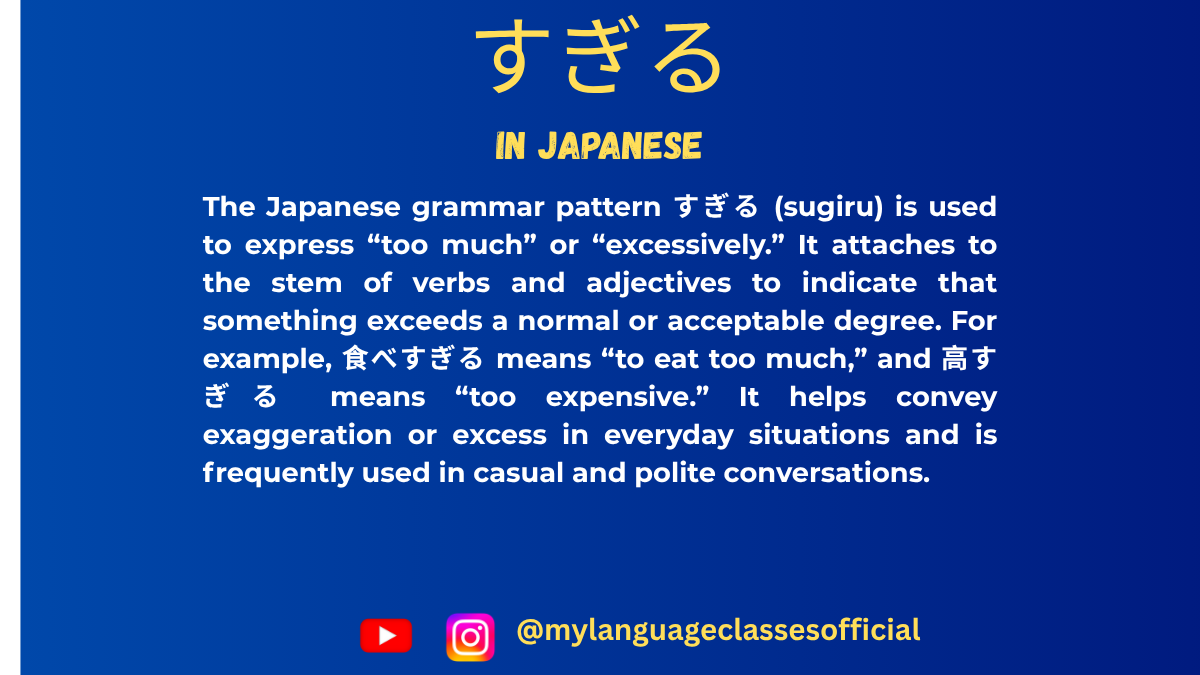Your cart is currently empty!
Tag: Japanese verb stem
-

How to Use すぎる in Japanese | My Language Classes
Mastering すぎる: The Key to Expressing Excess in Japanese
When learning Japanese, one of the most versatile tools in your linguistic arsenal is the suffix すぎる (sugiru). This simple yet powerful expression allows you to convey the idea of “too much” or “excessively” with verbs, adjectives, and more. In this blog, we’ll explore how to use it, provide practical examples, and share cultural insights to help you avoid common mistakes.
What Does すぎる Mean?
At its core, すぎる means “to go beyond” or “to exceed.” When attached to the root of a verb or adjective, it transforms the phrase to mean “too much” or “overly.”
For example:- 食べすぎる (tabesugiru): to eat too much.
- 高すぎる (takasugiru): too expensive.
- 使いすぎる (tsukaisugiru): to use too much.
This construction works seamlessly in a wide variety of situations, making it an essential element of everyday conversation.
How to Use すぎる with Verbs
To use すぎる with a verb, follow these steps:
- Take the stem form of the verb (the verb without its final ます in polite form or る in dictionary form).
- Attach すぎる directly to the stem.
Here are some examples:
- 食べる (taberu) → 食べすぎる (tabesugiru): to eat too much.
- 飲む (nomu) → 飲みすぎる (nomisugiru): to drink too much.
- 使う (tsukau) → 使いすぎる (tsukaisugiru): to use too much.
Example sentences:
- 昨日、ラーメンを食べすぎてお腹が痛い。
(Kinō, rāmen o tabesugite onaka ga itai.)
Yesterday, I ate too much ramen, and now my stomach hurts. - 飲み会でお酒を飲みすぎないように気をつけてください。
(Nomikai de osake o nomisuginai yō ni ki o tsukete kudasai.)
Please be careful not to drink too much at the party.
How to Use すぎる with Adjectives
For adjectives, the method depends on whether you’re dealing with an い-adjective or a な-adjective:
1. い-Adjectives
Remove the final い, then add すぎる.
- 高い (takai) → 高すぎる (takasugiru): too expensive.
- 暑い (atsui) → 暑すぎる (atsusugiru): too hot.
Example sentence:
- この服は高すぎて買えない。
(Kono fuku wa takasugite kaenai.)
This clothing is too expensive to buy.
2. な-Adjectives
Simply add すぎる to the base form of the adjective.
- 簡単な (kantanna) → 簡単すぎる (kantansugiru): too simple.
- 静かな (shizukana) → 静かすぎる (shizukasugiru): too quiet.
Example sentence:
- 試験が簡単すぎてびっくりしました。
(Shiken ga kantansugite bikkuri shimashita.)
The test was too easy, and I was surprised.
Nuances and Cultural Tips
- Politeness Matters
In Japanese culture, expressing something as “too much” can sometimes feel blunt. To soften your tone, consider adding phrases like ちょっと (chotto) or using a more indirect expression:
- このラーメン、ちょっと辛すぎると思います。
(Kono rāmen, chotto karasugiru to omoimasu.)
I think this ramen is a little too spicy.
- Avoid Overusing It!
While すぎる is incredibly useful, overusing it can make your speech sound overly critical or negative. Balance it with positive expressions to maintain politeness and harmony in conversations. - Watch for Literal vs. Figurative Use
Sometimes, すぎる is used figuratively:
- 考えすぎる (kangaesugiru): to overthink.
- 頑張りすぎる (ganbarisugiru): to try too hard.
These can reflect emotional or mental states rather than physical actions.
Practice Makes Perfect
To truly master すぎる, try creating your own sentences! Use these prompts:
- What’s something you’ve done “too much” recently?
(食べすぎる, 寝すぎる, 遊びすぎる) - Describe something that felt excessive or overwhelming.
(高すぎる, 静かすぎる, 複雑すぎる)
Conclusion
The すぎる construction is indispensable for describing excess in Japanese. Whether you’re eating too much, overthinking, or facing something outrageously expensive, すぎる lets you express it all with precision and nuance.
So, next time you’re practicing Japanese, try experimenting with すぎる. Not only will it enhance your vocabulary, but it will also deepen your understanding of Japanese culture and conversational dynamics.
Happy learning, and don’t study すぎる (sugiru) much! 😊
If you enjoyed this lesson, be sure to check out more posts like this on my blog at My Language Classes. Don’t forget to subscribe my YouTube channel and follow me on Instagram for the latest language learning tips and lessons. Leave a comment below to share your thoughts, or ask any questions you have about nouns.
Happy learning! 😊
